 |
|
“Yi Series No.1: Magic Cube” Installation | Artificial silk, cocoon, xuan paper, linen, bamboo, metal frame | 480 x 320 x 240cm | 1988 |
Liang Shaoji was born in Shanghai, China in 1945. He graduated from the affiliated middle school of Zhejiang Academy of Fine Arts in 1965 and studied in Varbanov Institute of Tapestry in Zhejiang Academy of Fine Arts from 1986 to 1989. Liang Shaoji engaged in the creation of flax-spinning and weaving arts and crafts in the 1960s. This experience cultivated his sensitivity to fiber materials and the habit of hands-on experiments. In the late 1970s, Liang Shaoji transferred to the Overseas Exhibition Office of the Light Industrial Ministry in Beijing and worked there for more than two years. The experience of setting up exhibitions in large spaces prompted the artist the idea of combining sculpture, painting, architecture, and craftsmanship. In 1989, he returned to Taizhou, Zhejiang, and began to patiently observe and familiarize himself with the life cycle and behavioral characteristics of silkworms.
The experience and knowledge accumulated in raising silkworms, watching silkworms, using silkworms as a medium, and long-term on-site operation and breeding allows Liang Shaoji to fully understand the sound, color, shape and taste of silkworms throughout their lives, providing rich nourishment for transforming them into artistic language and expression in his creation and maximizing the use of natural ecology that can be developed into an art. Liang Shaoji has not only used silk for modeling, but also used various sounds, shapes, dynamics, smells, and even excrement throughout the lives of silkworms. Bamboo, wood, water, and clouds related to sericulture have also been included in his creations. He has believed that materials are spiritual, but the spirituality of materials must be explored through experiments and cannot be constrained by preconceptions. Because of his pursuit of conformity to natural rhythms and contingencies, Liang Shaoji's creative cycle is often very long, which lasts for months, years, or even decades. Many works are not completed at once. The artist has also used video in the process of tracking the lives of silkworms, and then developed it into video art, at the same time, he also incorporated performance art and dance and other forms into his creation. For the artist, the sericulture experiment has three meanings: first, it is a way to loosen the bonds of decorative tradition; second, it draws a line between his work and that of silkworm growers; and third, it is a reply to the century of biology.
 |
|
“Yi Series No.1: Magic Cube” Installation | Artificial silk, cocoon, xuan paper, linen, bamboo, metal frame | 480 x 320 x 240cm | 1988 |
 |
|
In 2001, Liang Shaoji's studio moved to the Tiantai County Museum, at the foot of the Tiantai Mountain in Zhejiang Province. It is the birthplace of Tiantai Buddhism. Looking out from the studio, the clouds and mist are lingering, and the eyes are filled with lush greenery. |
Silkworms evolved from wild silkworms. About five thousand years ago, the Chinese began to domesticate wild silkworms. Liang Shaoji has believed that the production of sericulture can be transformed into artistic behavior through artistic observation. Silkworm are a kind of lepidopteran insects, their life cycle is about 50 days. They will undergo a complete metamorphosis process, and the shapes of each stage of life changes greatly. The growth of silkworms will go through these stages: eggs, ants, adults, pupae (cocoons) and moths. A silkworm eats mulberry leaves to grow and shed its skins once when it grows to a certain extent. After four moltings, the silkworm begins to spin silk, turning into an oval cocoon, enveloping itself in it,and metamorphosing into a pupa. Finally, the silkworm moth broke out of its pupa. The wings of silkworm moths are small and weak, unable to fly. After mating, the male moth dies, while the female moth dies after laying eggs. Silk is an animal protein secreted by the silk glands of silkworms, and silkworm spinning is the most primitive "natural weaving".
|
|
|
Silkworms are eating mulberry leaves. |
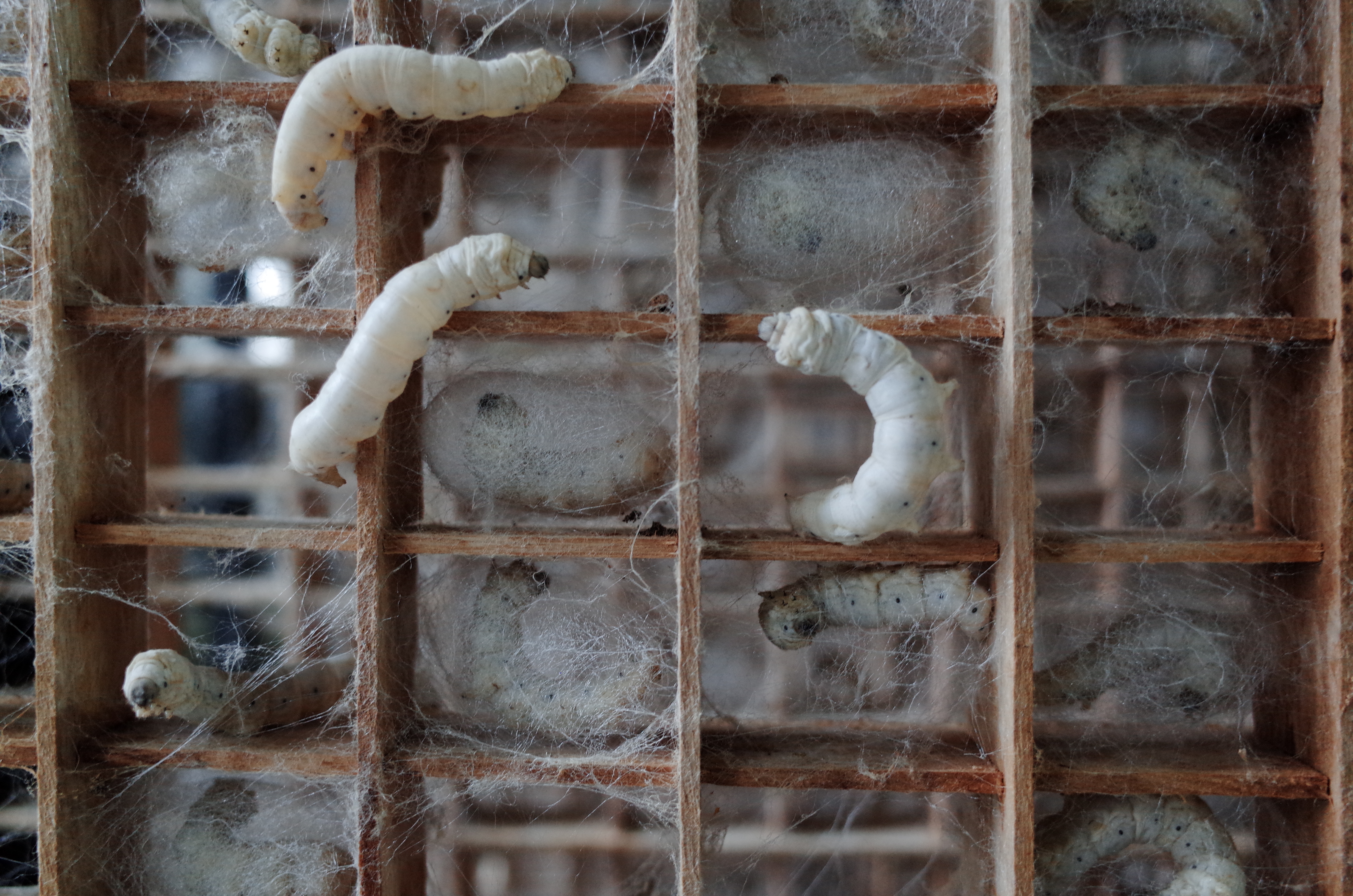 |
|
Mature Silkworms are spinning on checkered clusters. |
The endless life process of silkworm hatching, growing, spinning, cocooning, emerging, and egg-laying is his core creative medium. He immersed himself in this process, and then turned into“I am a silkworm", as if co-existing and co-transforming with the silkworm. His studio has been a sericulture laboratory. He has insisted on making detailed records of silkworm rearing, observing the crawling state of silkworms, the dynamics and shapes of spinning, and being familiar with the smell and sound of silkworms. He has taught himself several textbooks on sericulture and subscribed to academic journals such as "Science of Sericulture" to follow up on the latest scientific research results. He not only consulted the silkworm experts at Zhejiang Agricultural University on the biological clock and pathology of silkworms but also visited the municipal silkworm egg-producing farms and participated in the work of hybrid breeding and production of silkworm eggs under the guidance of production staff. Liang Shaoji worked with mulberry farmers in the countryside of Linhai City, Zhejiang Province, to gather mulberry and feed silkworms. He once built a greenhouse to control the growth of mulberry and tried to raise silkworms outside of the traditional spring and autumn sericulture season. When the silkworms are spinning, he will wait all night by the silkworm house and observe carefully, even for four or five days. Over the past 30 years, the artist has raised more than 900,000 silkworms, and if each silkworm produces about 1,000 to 1,200 meters of silk, which means that the silk he used can circle the earth for more than 10 times.
In long-term practice, Liang Shaoji has accumulated a lot of experience and cultivated a high degree of sensitivity to the patterns, shapes, and materials of silkworms’ lives, "Curiosity drives me to continue to explore. I found that when the mind is relaxed, the extraordinary sensitivity will emerge spontaneously, I can understand the general laws of motion, biological habits, and certain special life miracles of silkworms from things that I have never seen before or from accidents. From the crawling state of silkworms to the shape of silking, as well as the influence of the silkworm house, biological clock, light, smell, temperature, and humidity changes on silkworms, all these can all be converted into artistic factors, and become the entrance to the modeling experiment, and even become the main body of life art."
Liang Shaoji spent a lot of time studying the survival of silkworms on different mediums and the form of spinning. The knowledge and technical methods of sericulture provided the necessary support for Liang Shaoji’s creation. At the same time, the artist moderately used biological high-technology to conduct aesthetic thinking based on the understanding of genetic knowledge, and also prevented brutal human intervention. For example, Liang Shaoji cleverly used the characteristics of a flat cocoon for modeling, adjusting the biological clock of silkworms by changing factors such as humidity, temperature, and light, so as to control the direction, speed, and shape of spinning, and finally forming a flat structure of silk which is easy to shape and easy to observe in-depth during the spinning process, revealing the possibility of transforming various silkworm behaviors into artistic language. For another example, silkworms are close to materials that contain lignin such as wood and paper; they are more resistant to materials that do not contain lignin, such as metal, glass, and plastic. Liang Shaoji conducted a large number of experiments to improve the immunity and adaptability of silkworms through eggs selection and hybridization, and cultivated silkworm eggs that can adapt to the human bodies, discarded metals, plastics and glass, and other different materials,
"In the past, scientific researchers and silkworm growers only wanted to improve the quality and yield of cocoons and the silk reeling process. They had never studied the possibility of silk sculpture, so they did not study the relationship between silk and other man-made materials. They only based on biophysical properties to explain that silkworms eat leaves, so they feel comfortable with materials containing lignin. For example, papers contain wood fibers, so silkworms can get along with papers. Metals, especially industrial waste metals with a strange smell and greasy dirt on them, are of course not suitable for silkworms who love cleanliness. This is the starting point for my philosophical thinking and aesthetic thinking, to ask about the circumstances and abilities of life. Domestic silkworms evolved from wild silkworms. The wild silkworms have stronger immunity, the domestic silkworms have lower immunity and climbing ability but they have very advanced silk glands, which is the result of human domestication. To make silkworms able to adapt to metal, I had to optimize the breeds through selective breeding and interbreeding to improve their immunity. Second, the silkworm’s spinning is controlled by its biological clock. I had to adjust the temperature, humidity, and utilize smell and light to control the silkworm’s spinning direction. It was very difficult to make the silkworms spin on a human body, which challenges the life limits of both silkworms and humans. Silkworms don't like the smell and sweat of the human body. Also, humans can't tolerate insect stings and can't stop moving for a long time. But I found that if the density of silkworms is high, their smell overwhelms the smell of the human body, which is better. I continue to gain experience in practices, master the patterns, and make adjustments in time. "
 |
|
"Self-roped / Nature Series No. 31" Performance art | 5th Lyon Biennale, Museum of Contemporary Art of Lyon, France | 2000 |
Liang Shaoji's creation have paid great attention to accidental effects. He has generally made a rough idea at the beginning of his creation, designed several concepts, and after silkworms started to spin, he adjusted the concept and modeling method appropriately according to the situation. Sometimes he may control the shape of the silk cocoon, but more often, he will let silkworms spin and shack the silk by themselves. For example, he found that in a low temperature and humid environment, the silk structure becomes loose.The unexpected spinning of silkworms flooded and surrounded the metal base of work, which inspired the artist to create "Snow Cover".
 |
|
“Snow Cover No.1” Installation | Silk, cocoons, paper cups, plastic cups, metal, wood | 17 x 122 x 244cm | 2013 - 2014 |
 |
|
“Snow Cover No.1”(detailed view) Installation | Silk, cocoons, paper cups, plastic cups, metal, wood | 17 x 122 x 244cm | 2013 - 2014 |
 |
|
“Snow Cover No.1”(detailed view) Installation | Silk, cocoons, paper cups, plastic cups, metal, wood | 17 x 122 x 244cm | 2013 - 2014 |
The "Nature series" which started in 1989 is still ongoing. The series with time and life as the core, and the modeling method of interaction between humans and nature as the characteristic. It covers sculptures, textiles, installations, performance art, and new media, and has created more than 250 works so far, which is Liang Shaoji's masterpiece.
This period was the initial period of the "Nature series", including the birth of the concept of using silkworms as a creative medium, the research and familiarization of silkworm nature, and the breakthrough in grasping silkworm nature to make the new language of silkworms as a medium possible. During this period, the artist did a lot of experiments, allowing silkworms to spin on scrap metal, glass, and human bodies for experiments. These practices that seemed to violate the law and the nature of silkworms were realized based on Liang Shaoji's years of experience in sericulture and repeated experiments. For example, a silkworm expert from Zhejiang Agricultural University once told Liang Shaoji that silkworms are extremely sensitive and cannot tolerate the smell of metals, so they cannot spin silk on metals. However, Liang Shaoji has believed that the orientation of sericulture production and research was to produce silk more neatly and evenly, so he tried to open up the other side of silkworms and explored more possibilities. Liang Shaoji selected silkworm eggs with strong physical strength, good immunity, and high tolerance through continuous crossbreeding in the silkworm egg-producing farm. After raising tens of thousands of silkworms in the countryside, he moved them into the studio and conducted creative experiments.
 |
|
“Beds / Nature Series No.10” Installation | Burnt copper wire, silk, cocoon | Approximate display size 800 x 200 cm,44 pieces | 1993 - 1999 |
 |
|
“Beds / Nature Series No.10”(detailed view) Installation | Burnt copper wire, silk, cocoon | Approximate display size 800 x 200 cm,44 pieces | 1993 - 1999 |
At this stage, Liang Shaoji’s installations and performance arts are full of tension and confrontations—silk and iron, dynamic and static, light and heavy, big and small, both visually and conceptually shocking people. In "Beds/Nature Series No.10", the artist used the burnt enameled wire from the discarded motor to make many tiny beds, then he cultivated the silkworms and let them spin on the beds, year after year, the process went on. This work was made from 1992 to 1999. In the beginning, the bed was made too big, later he found that the enlarged bed destroyed his sympathy for silkworms. Only the tiny bed that fits the silkworm, can present the meaning of the equality of things.
 |
|
“Nature Series No.25” Single-channel video | 5′36″ | 1999 |
Based on the first stage, the artist continued to explore the mediums, forms, and material languages more deeply. However, the works of this period paid more attention to the whole life process of the silkworm and the internal energy in it. He created a long silk-foil scroll "Broken Landscape", which did not control the shape, and represented the lifecycle of silkworms from ants to moths. And also created the installation "Listening to the silkworms", which recorded the sound of silkworms spinning and becoming a moth. The works of this period not only expressed the consciousness of life, but also showed the expression of softness to overcome rigidity, and appeared reflective and restrained works.
|
|
|
“Broken Landscape” Installation | ancient camphor wood, silk, cocoon | 2008 – 2009 |
In a year with a lot of rain, silkworms ate the mulberry leaves with high water content, they also urinated while spinning. Therefore, the foil was often wet and yellow, which inspired the artist to create this work. The artist described the lifecycle of silkworms as “an infinitely fine line”. The long silk scrolls and layers of silk nets recorded all traces of their life deformation, including the excretions. Silkworms spin, excrete, molt, pupate, copulate until death on the large silk, leaving eggs, cocoons, pupae, moths, and the excrements, and other special smells. The traces left by the life process of silkworms form a "natural state" texture, which was place together with the ancient camphor wood, just like an ancient Chinese landscape painting. The inspiration for this piece came from an accident.
 |
|
“Broken Landscape” Installation | Ancient Camphor wood, silk, cocoon | 2008 – 2009 |
 |
|
“Listening to the silkworms/ Nature series No.96” Installation | Live silkworms, mulberry leaves, microphones, headsets, tape recorders, bamboo plaques, wooden shelves | 2006 |
 |
|
“Listening to the silkworms/ Nature series No.96” Installation | Live silkworms, mulberry leaves, microphones, headsets, tape recorders, bamboo plaques, wooden shelves | 2006 |
 |
|
“Listening to the silkworms/ Nature series No.96” Installation | Live silkworms, mulberry leaves, microphones, headsets, tape recorders, bamboo plaques, wooden shelves | 2006 |
 |
|
“Cloud Mirror/ Nature Series No.101” Photography| 100 x 150cm | 2007 |
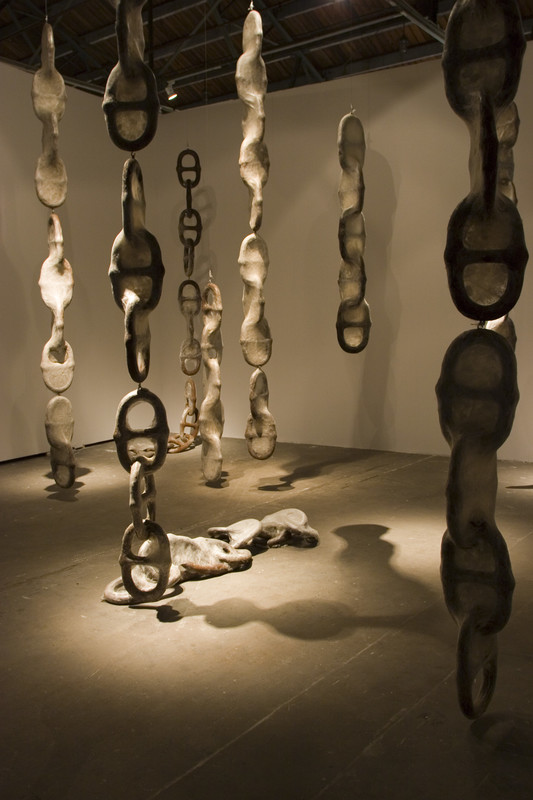 |
|
“Chain: The Unbearable Lightness of Being/Nature Series No.79” (detailed view) Installation | Hollow resin, iron powder, silk, cocoon| 2003 - 2007 |
From the "Beds" to "The Unbearable Lightness of Life" in the "Nature series", the silkworms have climbed from the small wire bed twisted from the remains of the scrapped motors to the giant iron chains that hung high from the ceiling. The silkworms in Liang Shaoji's studio even challenged more difficult and dangerous "tasks". Liang Shaoji had his principles, "It's not immobility, the first is to respect, and second is to reduce harm". These works were his trial, exploration and questioning of the complicated relationship between the state of life and the living environment.
The artist described the third stage as vagueness, transparency, insubstantiality, and meditation, like the aesthetic characteristics of the East, but without losing rational and philosophical thinking, revealing the current situation and care about humanity.
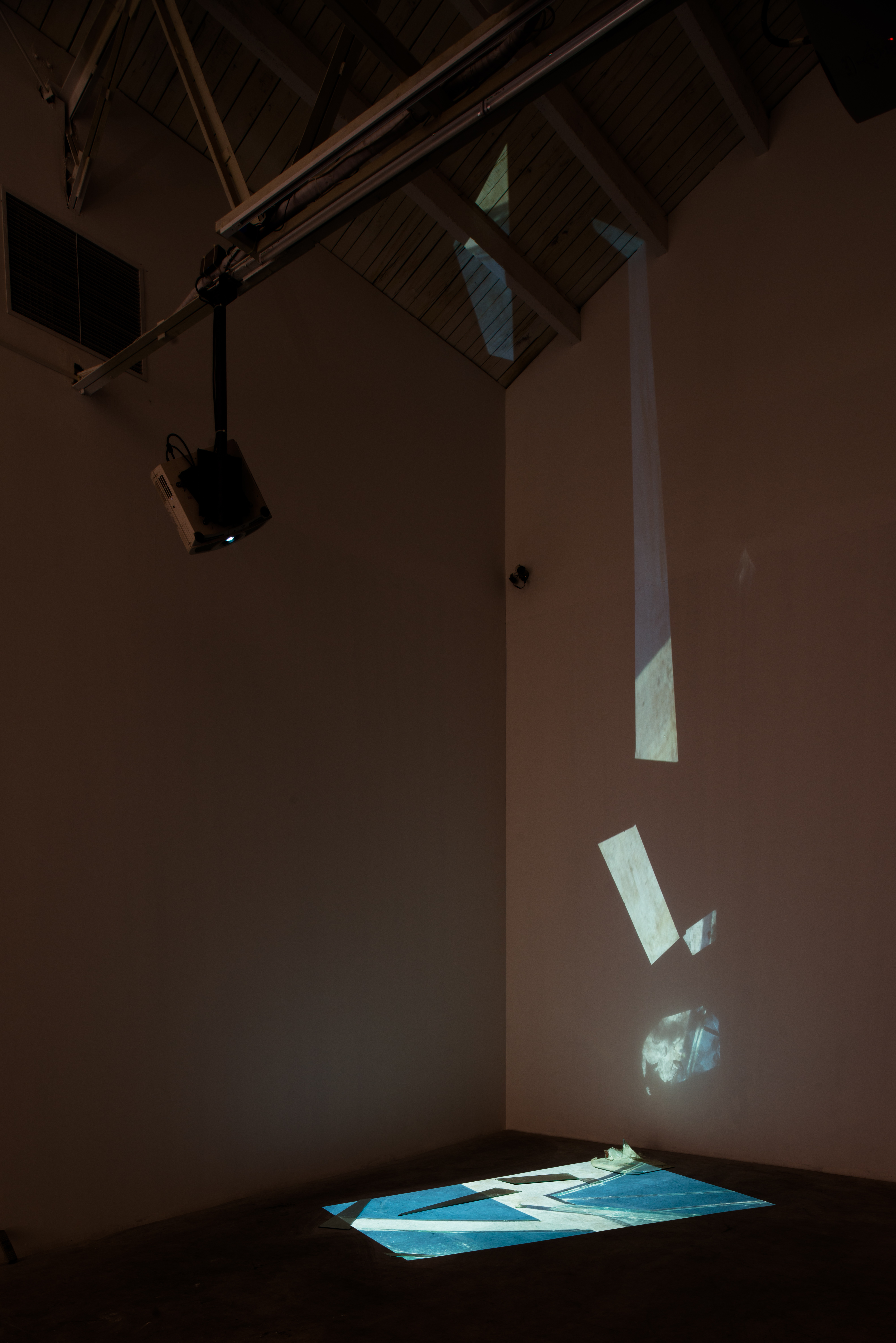 |
|
“Mending sky” Installation, video, single-channel video | 5′43″ | 2011 |
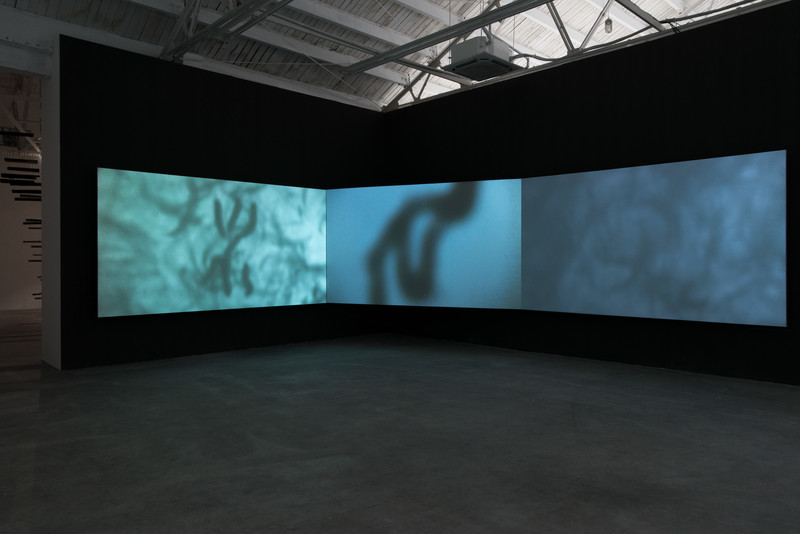 |
|
“Stele” Three-channel video | 10′6″ | 2008-2014 |
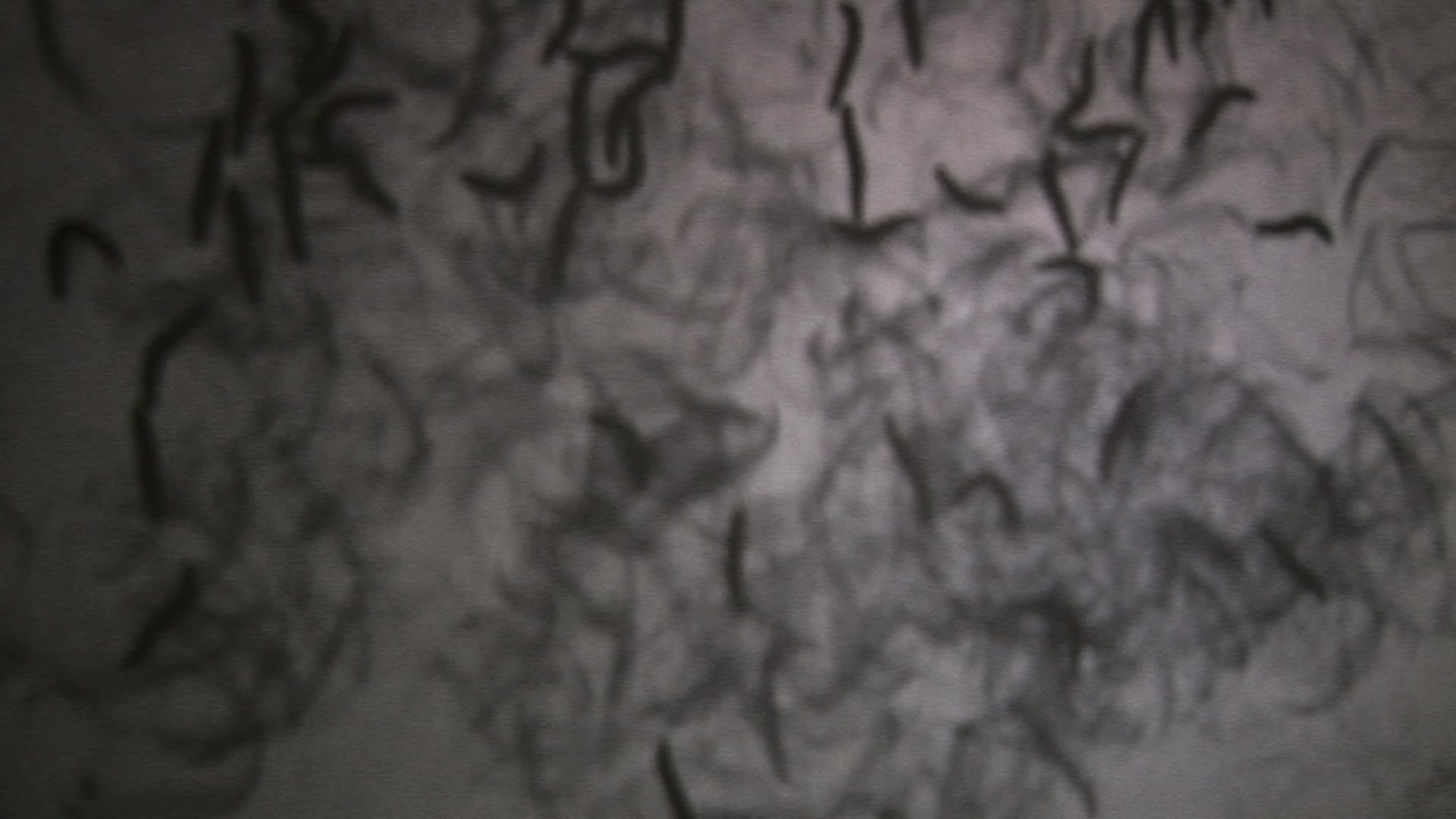 |
|
“Stele”(still frame) Three-channel video | 10′6″ | 2008-2014 |
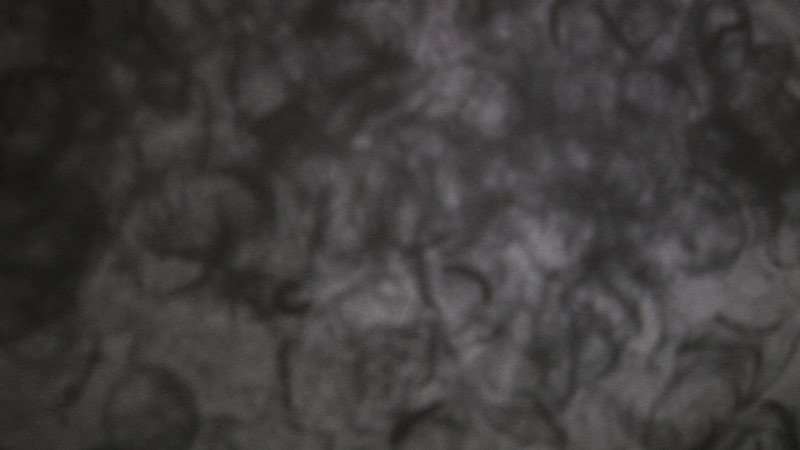 |
|
“Stele”(still frame) Three-channel video | 10′6″ | 2008-2014 |
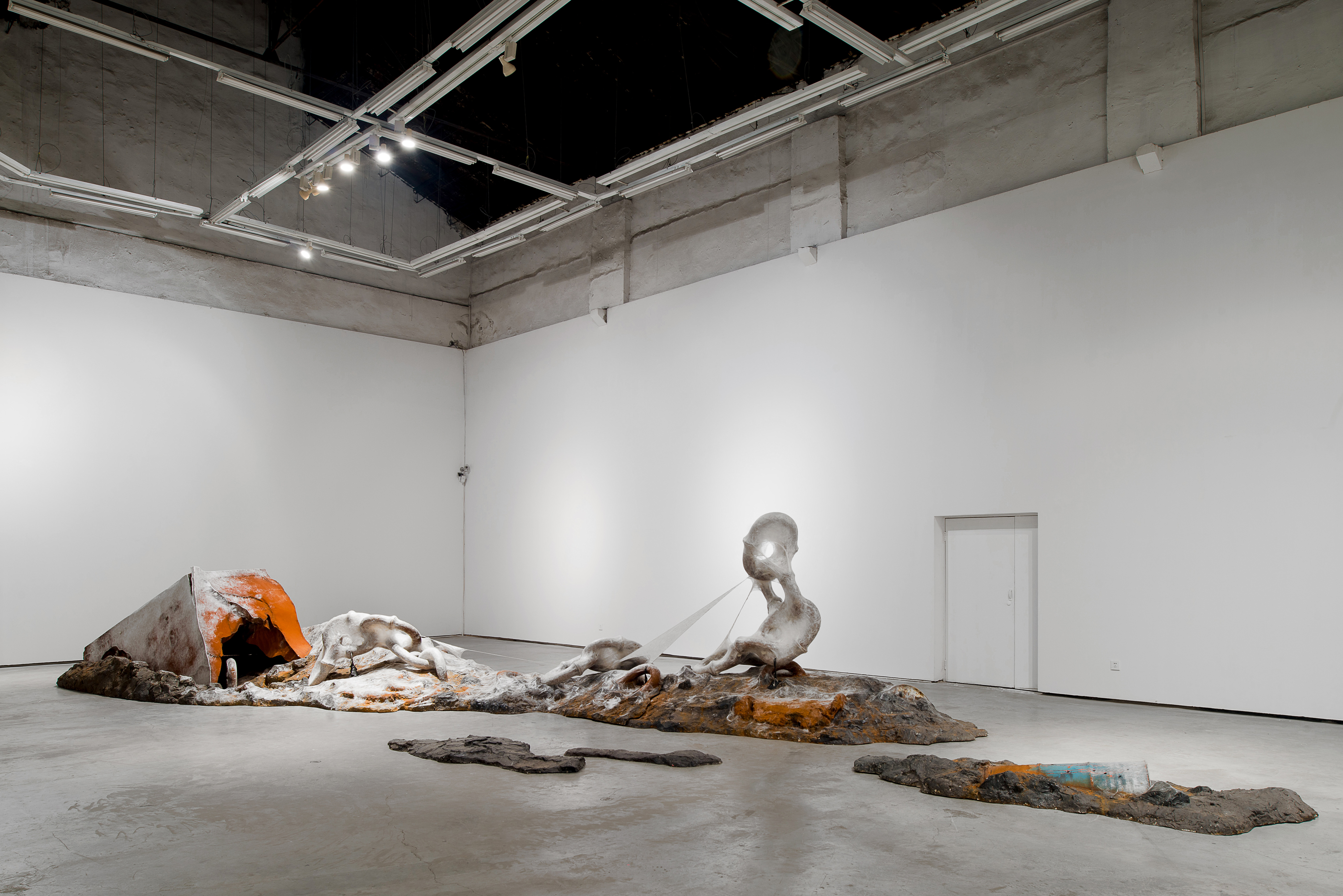 |
|
“Destiny” Installation | Silk, cocoons, iron plate, iron powder, oil barrel, polyurethane colophony, acrylic, yellow sand | 180 x 1250 x 350 cm | 2012 – 2014
|
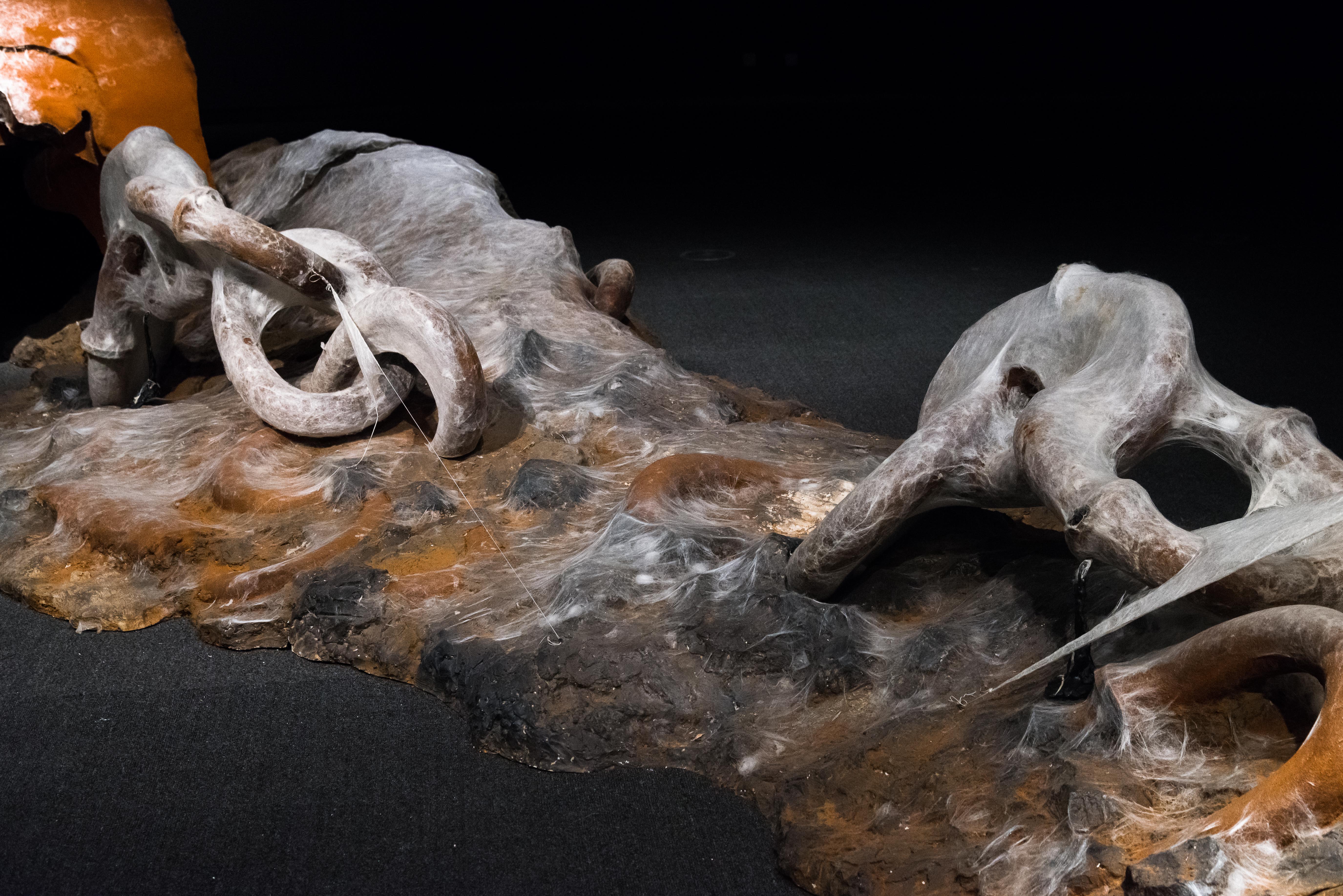 |
|
“Destiny”(detailed view) Installation | Silk, cocoons, iron plate, iron powder, oil barrel, polyurethane colophony, acrylic, yellow sand | 180 x 1250 x 350 cm | 2012 – 2014 |
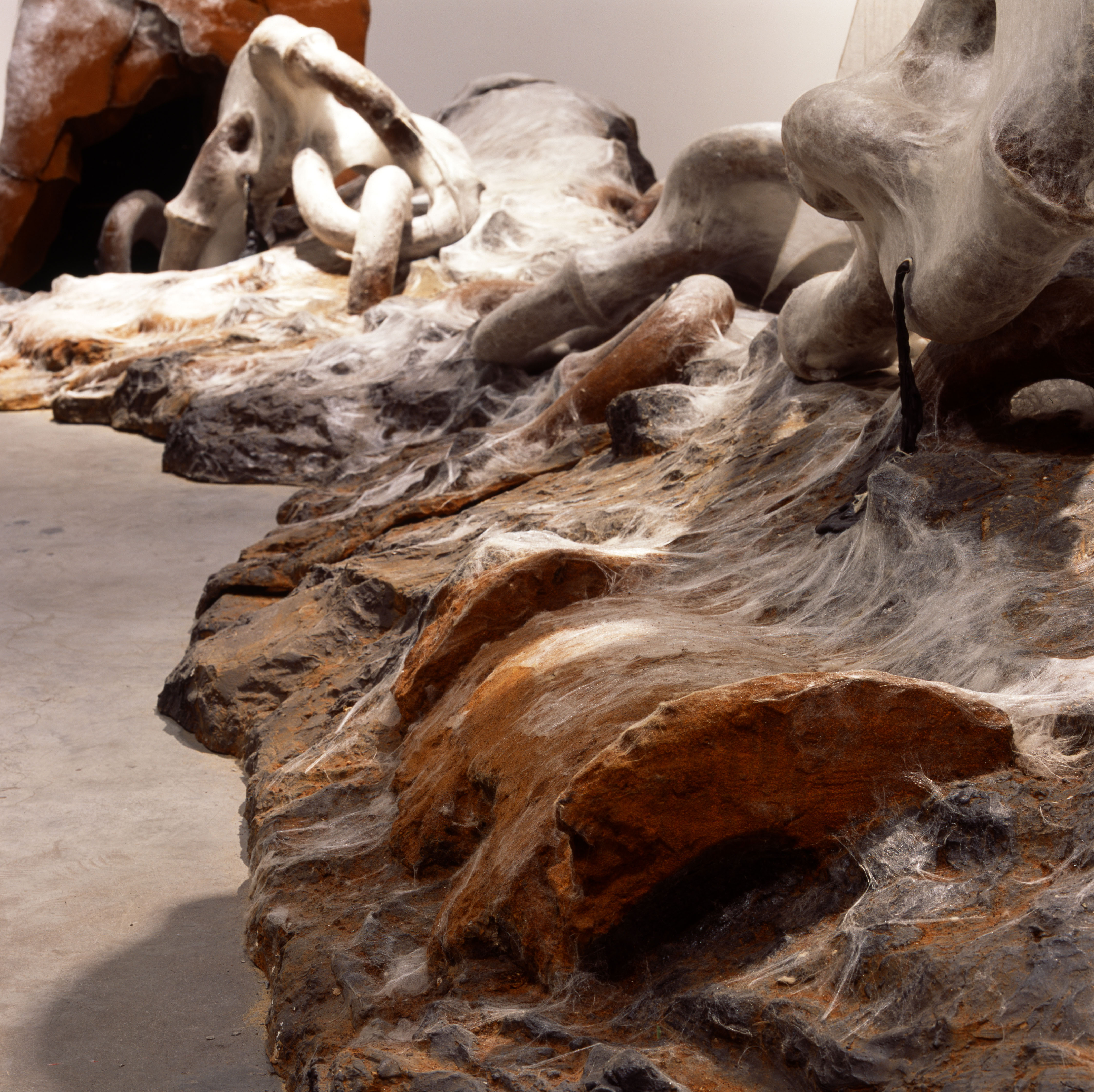 |
|
“Destiny”(detailed view) Installation | Silk, cocoons, iron plate, iron powder, oil barrel, polyurethane colophony, acrylic, yellow sand | 180 x 1250 x 350 cm | 2012 – 2014 |
 |
|
“Destiny”(detailed view) Installation | Silk, cocoons, iron plate, iron powder, oil barrel, polyurethane colophony, acrylic, yellow sand | 180 x 1250 x 350 cm | 2012 – 2014 |
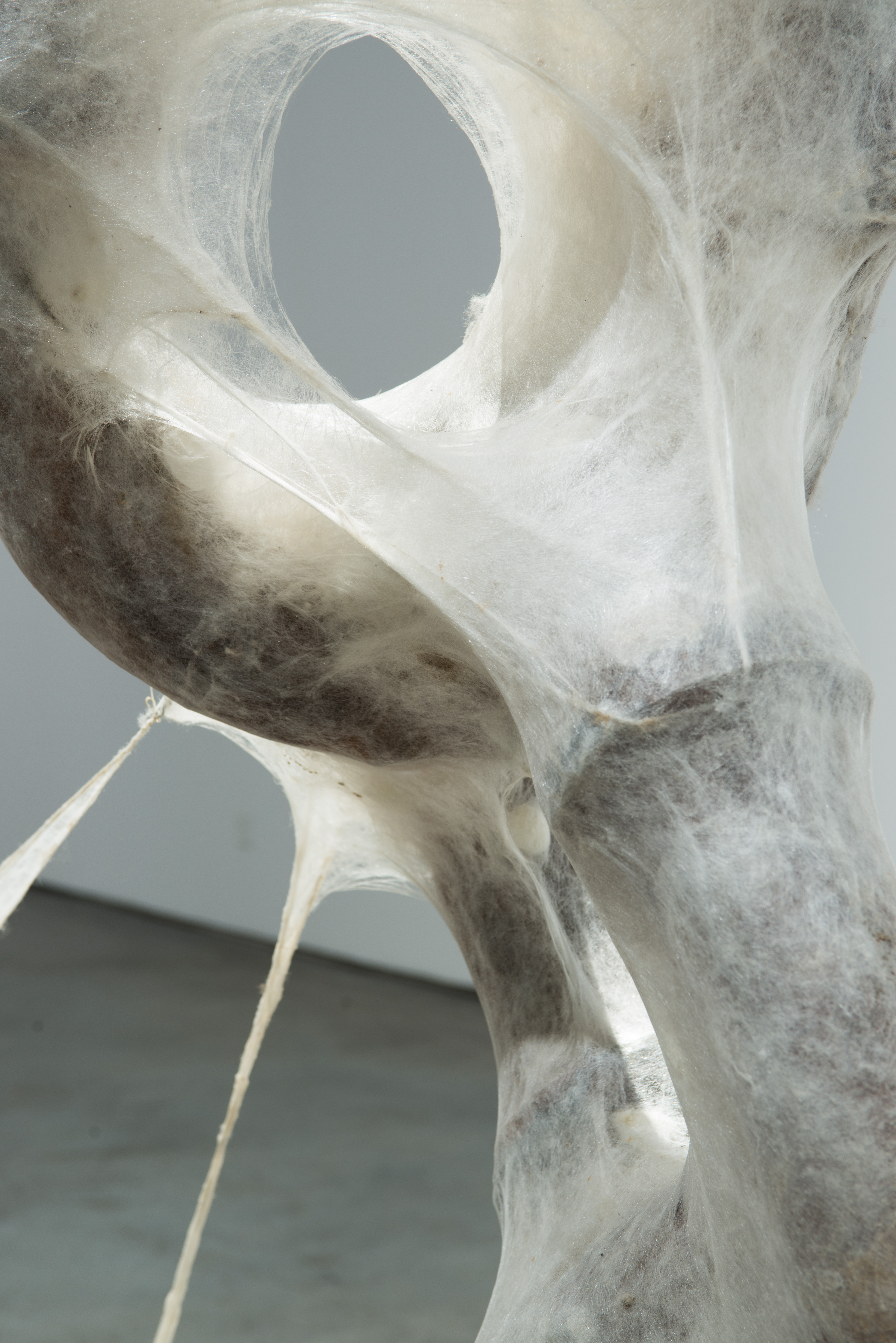 |
|
“Destiny”(detailed view) Installation | Silk, cocoons, iron plate, iron powder, oil barrel, polyurethane colophony, acrylic, yellow sand | 180 x 1250 x 350 cm | 2012 – 2014 |
 |
|
“Planar Tunnel” Installation | Silk | Φ145cm | 2012 |
The works of this stage set up strong confrontation and slowly internalized it into a peaceful visualization, paying more attention to the movement, life, and connection of the silkworm with everything around it, and questioning philosophical propositions such as spirit, life, death, and nature. Thinking about the origin of life, Liang Shaoji has adopted an open attitude, integrating the wisdom of science and religion, and completed the transformation from "tool" to "Tao" (means natural order of the universe in Chinese)in his co-creation with silkworms; reflected in his works, he has selected more non-industrial produced materials, such as ancient wood, bamboo, and pebbles, and has also reduced intervention in the silkworm spinning process. For example, in the set of silk pieces in "Planar Tunnel", the texture and thickness of the silk fibers are different, the artist successfully mastered and used the changes in the head swing amplitude of silkworms at different stages of spinning and cocooning after years of observation, and finally completed the works.
|
|
|
“Time and Permanence/Nature Series No.2" Installation | Silk, cocoon, rusty iron bracket | 1992 - |
The timeliness and nature of Liang Shaoji's works were also reflected in the way the works were displayed, making them a dialogue with the environment. The same work was showed in different exhibition spaces, not only different in the method of construction and the volume of the installation, but also different in the way of working with silkworms. For example, when "Listening to the silkworms" was exhibited in Kosovo, the exact result of the moths breaking out of the cocoon at the opening ceremony was calculated strictly according to the countdown to the life cycle of silkworms. For Liang Shaoji, "Nature is endless, and I can't stop creating. The pursuit of 'truth', 'plain', and 'emptiness' of artistic language and the dialogue of the current situation, the continuous questioning of time and life has become a powerful creative driving force, silk and poems are connected."
(The text is based on the dialogue between Yang Jing and Liang Shaoji, the article "Silkworm Tao-The Ecological Connotation of Liang Shaoji's "Nature Series", the dialogue between Xu Feixuan and Liang Shaoji, and the dialogue between the project team and Liang Shaoji. Thank you Liang Shaoji and ShanghART gallery for providing information and related assistance for this article. )
Image courtesy of the artist. All rights reserved.